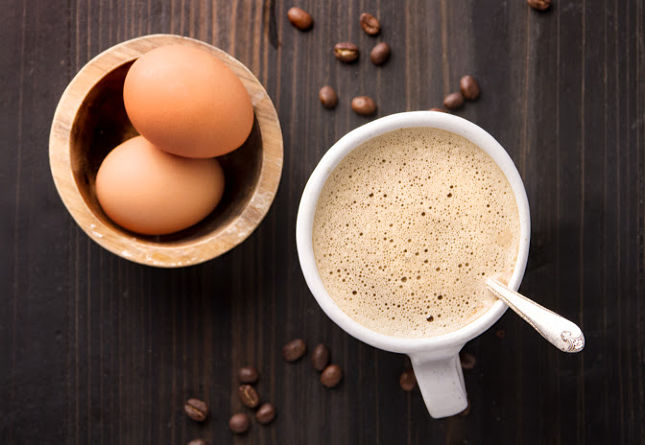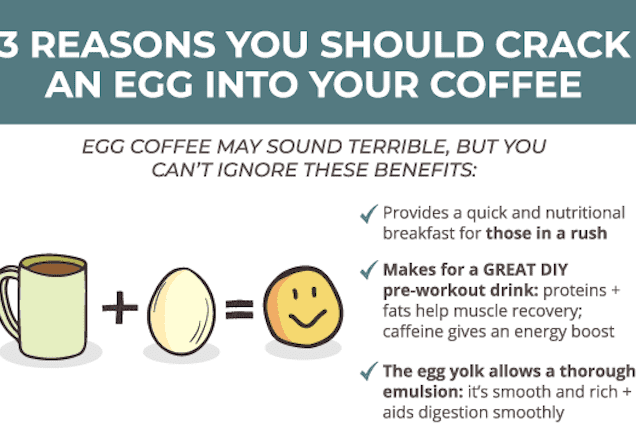When we talk about a “smooth” cup of coffee, we’re referring to a brew that balances flavor without harsh bitterness or acidity. Achieving this can be tricky for amateur baristas, but the Swedish egg coffee recipe offers a unique brewing method that can help you get it just right.
Can an egg actually improve your coffee? Absolutely—just ask any seasoned barista or coffee lover who’s tried it. The egg grabs onto the bitter compounds and unwanted stuff in the brew, giving you a smoother, cleaner, and more balanced cup. It’s a simple trick that makes a big difference.

Anyone who’s gone to culinary school and made consomme hundreds of times can attest that egg whites remove impurities from a liquid. When making consomme, a mixture of egg whites and raw ground chicken are stirred into a cloudy stock. As it slowly cooks, that mixture forms a “raft” on the top of the stock, attracting proteins and particles in the stock that cling to the raft, leaving behind a perfectly clarified consomme liquid. The raw egg in Swedish egg coffee serves a similar purpose.
Where Does Egg Coffee Come From?
Many baristas and coffee experts refer to this drink as “Scandinavian egg coffee” or “Swedish egg coffee.” So that means that this type of coffee hails from Sweden, Norway or Denmark, right?
Well, yes and no. virtually its unknown in Denmark, Sweden and Norway today.
That said, many believe egg coffee originated during the 19th-century wave of Scandinavian immigration to America. Coffee has a long history in Scandinavia, where people once used unusual substances to “clear” or clarify their brews.
He explained that back in the 1800s, coffee was pricey, so people would reuse the same grounds. This often made the coffee taste dirty and feel gritty. Back then, without sophisticated filtration methods, people used protein-rich substances like eggs, fish skins, and antlers to filter out impurities from coffee. Scandinavian immigrants likely introduced the idea of adding eggs to coffee in America. Today, though, it’s more accurate to call it “Midwest egg coffee,” since that’s where it’s still regularly consumed.
What Does an Egg do to the Coffee?
Can an egg really change the taste and quality of your coffee? Definitely. Our coffee experts and barista friends all agree—it’s a game-changer. The egg works like a natural filter, cutting down bitterness and leaving you with a smoother, richer cup every time.
The egg’s entire purpose is to change the flavor of the drink. “More specifically, the egg helps to remove the bitterness and acidity that accompanies poorly roasted coffee,The egg white acts, in a way, to remove impurities from the coffee, resulting in a tastier and cleaner cup of coffee.
Egg shells neutralize the acids in coffee, greatly reducing the tanginess and intensity of the cup. The result is much smoother and easier on the stomach, especially if you have gastric issues. If you just add yolks and egg whites, you’ll get the creamy, frothy texture, but the cup will be more acidic overall. Acidic coffee is not a bad thing ― just a matter of personal preference!”
Is Swedish Egg Coffee Safe to Drink?
Americans are especially wary of using raw eggs in their food, so egg coffee elicits questions and concerns about food safety. Janilyn Hutchings, a certified food safety professional from State Food Safety, cautioned that due to the water temperatures used to make egg coffee, there’s no guarantee that the egg will be free of salmonella.
“On one hand, since hot water intended for coffee usually doesn’t reach a boiling point while brewing, the egg may not fully cook during the brewing process,” she said. “Eating eggs that are only lightly cooked increases your risk of getting salmonella, especially if you’re using unpasteurized eggs.”
On the other hand, she said a handful of studies indicate that coffee grounds may have some antibacterial properties. One study, from July 2011 concluded that coffee “to have significant activity against the growth of food spoilage bacteria.” But Hutchings added that “the types of coffee these researchers studied weren’t as effective in preventing salmonella as they were in preventing other types of foodborne illness-causing bacteria.”
To bolster the overall safety of your egg coffee, she strongly recommended using the freshest pasteurized eggs possible. “The pasteurization process is designed to reduce bacteria like salmonella to safe levels, which will lower your chances of getting sick,” she said.

Recipe: How to Make Swedish Egg Coffee
Saxon, a seasoned coffee expert who’s tasted brews from around the globe, encourages curious coffee lovers to give Scandinavian egg coffee a shot. If you’re looking for a smoother cup with a bold kick to jumpstart your day, this might just be your new favorite morning ritual.
“Adding the egg to the coffee doesn’t add caffeine, but because the egg eliminates bitterness, you are able to make the brew time longer than normal, extracting more caffeine from the grounds,” Saxon told HuffPost.
Ingredients (for one serving)
- 3 tablespoons coarse-ground coffee (the same grind used when brewing in a French press)
- 10 ounces water (for brewing)
- 3 ounces cold water
- 1 egg (yolk, whites and shell)
Directions:
- Pour the 10 ounces of brewing water into a saucepan and place on the stove over medium-high heat.
- Start by adding your coffee grounds to a bowl or mug. Then crack an egg and drop the whole thing in—yep, shell and all—right on top of the grounds. Give it a good mix so everything combines evenly before moving on to the next step.
- Allow the coffee-egg mixture to sit for 30 seconds. Saxon says this brief pause lets “the coffee ‘bloom’ so that some of the bitter CO2 can escape.”
- Once the water begins to boil, add the coffee and egg slurry to the saucepan and reduce the heat to a gentle simmer. This is where the mixture starts to work its magic as the egg helps clarify the brew. Simmer for about 4 minutes (although, Saxon said, “this depends on your taste and the type of coffee you’re using, [so] feel free to adjust the brew time accordingly”).
- Remove the saucepan from the heat and allow to sit for 1 minute.
- Add the cold water. “This should make the coffee and egg crust combination sink to the bottom,” Saxon said. “This doesn’t always go according to plan, and you may have to add a little more cold water. If it doesn’t sink, use a slotted spoon to carefully fish out the crust.”
- The coffee you’ll want to drink has risen to the top at this point. Ladle or pour it through a sieve and into your server or cups.
More like this:
- What Happens to Your Body When You Eat Oatmeal Every Day
- What is Intermittent Fasting & How Should You do it

